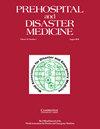Prehospital Surgical Cricothyrotomy in a Ground-Based 9-1-1 EMS System: A Retrospective Review.
IF 2.1
4区 医学
Q2 EMERGENCY MEDICINE
引用次数: 0
Abstract
BACKGROUND Airway management is a cornerstone in the prehospital care of critically ill or injured patients. Surgical cricothyrotomy offers a rapid and effective solution when oxygenation and ventilation fail using less-invasive techniques. However, the exact indications, incidence, and success of prehospital surgical cricothyrotomy are unknown, with variable rates reported in the literature. This study aimed to examine prehospital indications and success rates for surgical cricothyrotomy within a large, suburban, ground-based Emergency Medical Services (EMS) system. METHODS This is a retrospective analysis of 31 patients who underwent paramedic performed surgical cricothyrotomy from 2012 through 2022. Key demographic parameters were analyzed, including the incidence of cardiac arrest, call type (trauma versus medical), initial airway management attempts, number of endotracheal intubation (ETI) attempts before surgical airway, and average time to the establishment of a surgical airway in relation to the number of ETI attempts. Surgical cricothyrotomy success was defined as the acquisition of four-phase end-tidal capnography reading. The primary data sources were the EMS electronic medical records, and descriptive statistics were calculated. RESULTS A total of 31 patients were included in the final analysis. Of those who received a surgical cricothyrotomy, 42% (13/31) occurred in the trauma setting, while 58% (18/31) were medical calls. In all patients who underwent surgical cricothyrotomy, the median (IQR) time to the procedure was 17 minutes (IQR = 11-24). In trauma patients, the median time to surgical cricothyrotomy was 12 minutes (IQR = 9-19) versus 19 minutes (IQR = 14-33) in medical patients. End-tidal carbon dioxide (ETCO2) detection and placement success was confirmed in 94% (29/31) of patients. Endotracheal intubation was attempted in 55% (17/31) before subsequent surgical cricothyrotomy, with 29% (9/31) receiving more than one ETI attempt. The median time to surgical cricothyrotomy when multiple prior intubation attempts occurred was 33 minutes (IQR = 23-36) compared to 14.5 minutes (IQR = 6-19) in patients without a preceding intubation attempt. CONCLUSION Prehospital surgical airway can be performed by paramedics with a high degree of success. Identification of the need for surgical cricothyrotomy should be determined as soon as possible to allow for rapid securement of the airway and to ensure adequate oxygenation and ventilation.地面 9-1-1 紧急医疗服务系统中的院前环甲膜手术:回顾性分析。
背景气道管理是院前救治危重病人或伤员的基石。当使用微创技术进行氧合和通气失败时,外科环甲膜切开术是一种快速有效的解决方案。然而,院前外科环甲膜切开术的确切适应症、发生率和成功率尚不清楚,文献报道的比例也不尽相同。本研究旨在研究大型郊区地面急救医疗服务(EMS)系统中外科环甲膜切开术的院前适应症和成功率。方法这是对 2012 年至 2022 年期间接受辅助医务人员外科环甲膜切开术的 31 名患者的回顾性分析。分析了主要的人口统计学参数,包括心脏骤停的发生率、呼叫类型(外伤与医疗)、初始气道管理尝试、手术气道前气管插管 (ETI) 尝试次数,以及建立手术气道的平均时间与 ETI 尝试次数的关系。手术环甲膜切开术的成功定义为获得四相潮气末毛细血管造影读数。主要数据来源为 EMS 电子病历,并计算了描述性统计结果。在接受手术环甲膜切开术的患者中,42%(13/31)发生在创伤环境中,58%(18/31)为医疗呼叫。在所有接受手术环甲膜切开术的患者中,手术时间的中位数(IQR)为 17 分钟(IQR = 11-24)。在外伤患者中,手术环甲膜切开术的中位时间为 12 分钟(IQR = 9-19),而在内科患者中为 19 分钟(IQR = 14-33)。94%(29/31)的患者确认潮气末二氧化碳(ETCO2)检测和置管成功。55%的患者(17/31)在随后的手术环甲膜切开术前尝试过气管插管,29%的患者(9/31)尝试过不止一次气管插管。在之前多次尝试插管的患者中,手术环甲膜切开术的中位时间为 33 分钟(IQR = 23-36),而在之前未尝试插管的患者中,手术环甲膜切开术的中位时间为 14.5 分钟(IQR = 6-19)。应尽快确定是否需要进行外科环甲膜切开术,以便快速固定气道并确保充足的氧合和通气。
本文章由计算机程序翻译,如有差异,请以英文原文为准。
求助全文
约1分钟内获得全文
求助全文
来源期刊

Prehospital and Disaster Medicine
Medicine-Emergency Medicine
CiteScore
3.10
自引率
13.60%
发文量
279
期刊介绍:
Prehospital and Disaster Medicine (PDM) is an official publication of the World Association for Disaster and Emergency Medicine. Currently in its 25th volume, Prehospital and Disaster Medicine is one of the leading scientific journals focusing on prehospital and disaster health. It is the only peer-reviewed international journal in its field, published bi-monthly, providing a readable, usable worldwide source of research and analysis. PDM is currently distributed in more than 55 countries. Its readership includes physicians, professors, EMTs and paramedics, nurses, emergency managers, disaster planners, hospital administrators, sociologists, and psychologists.
 求助内容:
求助内容: 应助结果提醒方式:
应助结果提醒方式:


